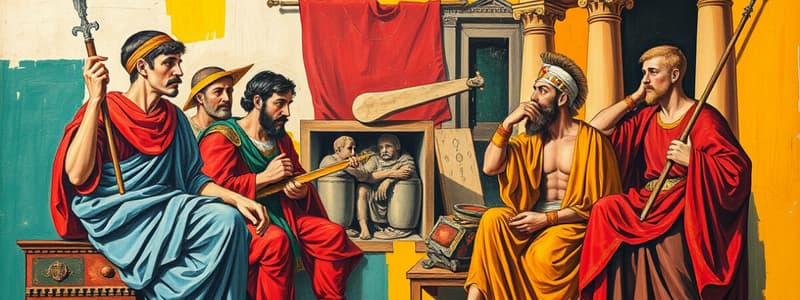Podcast
Questions and Answers
What was the group of wealthy, land-holding Romans known as?
What was the group of wealthy, land-holding Romans known as?
- Patricians (correct)
- Consuls
- Plebeians
- Senators
Who were the common people of Rome, including farmers and artisans?
Who were the common people of Rome, including farmers and artisans?
- Dictators
- Patricians
- Plebeians (correct)
- Senators
What was the role of the Senate in Roman government?
What was the role of the Senate in Roman government?
Law-makers
What were consuls in the Roman Republic?
What were consuls in the Roman Republic?
Consuls could veto each other's laws.
Consuls could veto each other's laws.
What is a dictator in the context of Roman government?
What is a dictator in the context of Roman government?
Who was Julius Caesar?
Who was Julius Caesar?
What was the role of a gladiator in ancient Rome?
What was the role of a gladiator in ancient Rome?
What river was Rome founded on?
What river was Rome founded on?
What defines a Republic?
What defines a Republic?
What were the Punic Wars?
What were the Punic Wars?
Who was Hannibal?
Who was Hannibal?
Flashcards are hidden until you start studying
Study Notes
Roman Social Classes
- Patricians were the wealthy, land-holding upper class in Rome, wielding significant power and influence.
- Plebeians consisted of the common people such as farmers, artisans, and merchants, holding little wealth or political power. They elected tribunes for representation.
Political Structure
- The Senate was composed of 300 members from the Patrician class, responsible for making laws and serving lifetime terms.
- The Roman Republic was led by two consuls, elected by the Senate, with distinct roles: one managed government affairs, while the other commanded military forces.
Government Powers
- The term veto, meaning "I forbid," allowed consuls to block each other's legislation, ensuring checks and balances.
- In crises, a dictator could be appointed, providing temporary total power to navigate urgent situations.
Key Historical Figures
- Julius Caesar became dictator in 45 BC, implementing reforms like redistributing land to the poor and expanding the Senate to 900 members, diminishing its original power. He was assassinated in 44 BC.
Entertainment and Culture
- Gladiators were typically prisoners, criminals, or slaves, trained to fight for entertainment, with the Colosseum being their primary arena.
Geographic Significance
- Rome was founded near the Tiber River, an essential geographical feature for its development.
Warfare and Expansion
- The Punic Wars (264-146 B.C.) were three conflicts between Rome and Carthage, resulting in Rome's victory and domination over the western Mediterranean.
- Hannibal, a Carthaginian general during the Second Punic War, famously attempted to invade Rome by traversing the Alps with soldiers and war elephants.
Studying That Suits You
Use AI to generate personalized quizzes and flashcards to suit your learning preferences.




